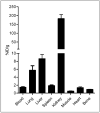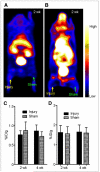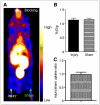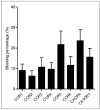PET imaging of chemokine receptors in vascular injury-accelerated atherosclerosis
- PMID: 23658218
- PMCID: PMC4251467
- DOI: 10.2967/jnumed.112.114777
PET imaging of chemokine receptors in vascular injury-accelerated atherosclerosis
Abstract
Atherosclerosis is the pathophysiologic process behind lethal cardiovascular diseases. It is a chronic inflammatory progression. Chemokines can strongly affect the initiation and progression of atherosclerosis by controlling the trafficking of inflammatory cells in vivo through interaction with their receptors. Some chemokine receptors have been reported to play an important role in plaque development and stability. However, the diagnostic potential of chemokine receptors has not yet been explored. The purpose of this study was to develop a positron emitter-radiolabeled probe to image the upregulation of chemokine receptor in a wire-injury-accelerated apolipoprotein E knockout (ApoE(-/-)) mouse model of atherosclerosis.
Methods: A viral macrophage inflammatory protein II (vMIP-II) was used to image the upregulation of multiple chemokine receptors through conjugation with DOTA for (64)Cu radiolabeling and PET. Imaging studies were performed at 2 and 4 wk after injury in both wire-injured ApoE(-/-) and wild-type C57BL/6 mice. Competitive PET blocking studies with nonradiolabeled vMIP-II were performed to confirm the imaging specificity. Specific PET blocking with individual chemokine receptor antagonists was also performed to verify the upregulation of a particular chemokine receptor. In contrast, (18)F-FDG PET imaging was performed in both models to evaluate tracer uptake. Immunohistochemistry on the injury and sham tissues was performed to assess the upregulation of chemokine receptors.
Results: (15)O-CO PET showed decreased blood volume in the femoral artery after the injury. (64)Cu-DOTA-vMIP-II exhibited fast in vivo pharmacokinetics with major renal clearance. PET images showed specific accumulation around the injury site, with consistent expression during the study period. Quantitative analysis of tracer uptake at the injury lesion in the ApoE(-/-) model showed a 3-fold increase over the sham-operated site and the sites in the injured wild-type mouse. (18)F-FDG PET showed significantly less tracer accumulation than (64)Cu-DOTA-vMIP-II, with no difference observed between injury and sham sites. PET blocking studies identified chemokine receptor-mediated (64)Cu-DOTA-vMIP-II uptake and verified the presence of 8 chemokine receptors, and this finding was confirmed by immunohistochemistry.
Conclusion: (64)Cu-DOTA-vMIP-II was proven a sensitive and useful PET imaging probe for the detection of 8 up-regulated chemokine receptors in a model of injury-accelerated atherosclerosis.
Keywords: atherosclerosis; chemokine receptors; molecular imaging; positron emission tomography; virus macrophage inflammatory protein.
Figures






Similar articles
-
PET/CT Imaging of Chemokine Receptors in Inflammatory Atherosclerosis Using Targeted Nanoparticles.J Nucl Med. 2016 Jul;57(7):1124-9. doi: 10.2967/jnumed.115.166751. Epub 2016 Jan 21. J Nucl Med. 2016. PMID: 26795285 Free PMC article.
-
CXCR4-Binding Positron Emission Tomography Tracers Link Monocyte Recruitment and Endothelial Injury in Murine Atherosclerosis.Arterioscler Thromb Vasc Biol. 2021 Feb;41(2):822-836. doi: 10.1161/ATVBAHA.120.315053. Epub 2020 Dec 17. Arterioscler Thromb Vasc Biol. 2021. PMID: 33327748 Free PMC article.
-
PET/CT imaging of chemokine receptor CCR5 in vascular injury model using targeted nanoparticle.J Nucl Med. 2014 Apr;55(4):629-34. doi: 10.2967/jnumed.113.132001. Epub 2014 Mar 3. J Nucl Med. 2014. PMID: 24591489 Free PMC article.
-
Metabolic and Molecular Imaging of Atherosclerosis and Venous Thromboembolism.J Nucl Med. 2017 Jun;58(6):871-877. doi: 10.2967/jnumed.116.182873. Epub 2017 Apr 27. J Nucl Med. 2017. PMID: 28450558 Free PMC article. Review.
-
Molecular imaging of atherosclerosis with integrated PET imaging.J Nucl Cardiol. 2017 Jun;24(3):938-943. doi: 10.1007/s12350-016-0766-y. Epub 2017 Jan 11. J Nucl Cardiol. 2017. PMID: 28078575 Free PMC article. Review.
Cited by
-
Radiotracers to Address Unmet Clinical Needs in Cardiovascular Imaging, Part 2: Inflammation, Fibrosis, Thrombosis, Calcification, and Amyloidosis Imaging.J Nucl Med. 2022 Jul;63(7):986-994. doi: 10.2967/jnumed.121.263507. J Nucl Med. 2022. PMID: 35772956 Free PMC article.
-
Current and novel radiopharmaceuticals for imaging cardiovascular inflammation.Q J Nucl Med Mol Imaging. 2020 Mar;64(1):4-20. doi: 10.23736/S1824-4785.20.03230-6. Epub 2020 Feb 18. Q J Nucl Med Mol Imaging. 2020. PMID: 32077667 Free PMC article. Review.
-
Perspectives on Small Animal Radionuclide Imaging; Considerations and Advances in Atherosclerosis.Front Med (Lausanne). 2019 Mar 11;6:39. doi: 10.3389/fmed.2019.00039. eCollection 2019. Front Med (Lausanne). 2019. PMID: 30915335 Free PMC article. Review.
-
PET/CT Imaging of Chemokine Receptors in Inflammatory Atherosclerosis Using Targeted Nanoparticles.J Nucl Med. 2016 Jul;57(7):1124-9. doi: 10.2967/jnumed.115.166751. Epub 2016 Jan 21. J Nucl Med. 2016. PMID: 26795285 Free PMC article.
-
Thermoneutrality but Not UCP1 Deficiency Suppresses Monocyte Mobilization Into Blood.Circ Res. 2017 Sep 1;121(6):662-676. doi: 10.1161/CIRCRESAHA.117.311519. Epub 2017 Jul 10. Circ Res. 2017. PMID: 28696252 Free PMC article.
References
Publication types
MeSH terms
Substances
Grants and funding
LinkOut - more resources
Full Text Sources
Other Literature Sources
Medical
Miscellaneous
